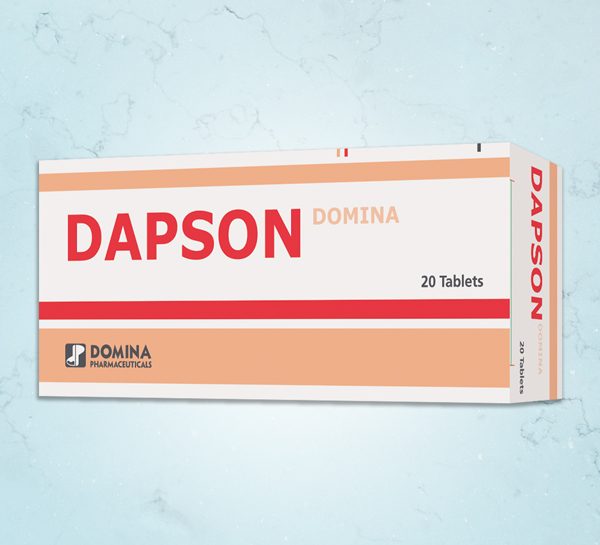
Composition:
Each tablet contains 100mg Dapsone.
Mechanism of action:
Dapsone has a wide spectrum activity against bacteria. But Dapsone is mainly used for its action against mycobacterium leprae. Dapsone is also used for treatment of Malaria. Dapsone is effective against plasmodium. Its mechanism is similar to that of sulphonamides, as it is also effective against p- amino benzoic acid.
Indications:
Dapsone is usually used for:
- Treatment of all cases of leprosy and dermatitis herpetiformis, and for prophylaxis of leprosy in persons in contact with leprosy patients.
- Prevention of malaria in combination with pyrimethamine.
- Prevention of pneumonia in immunodeficient patients, especially in AIDS patients.
Dosage:
- In leprosy: 1-2 mg/Kg daily, i.e. 50-100mg daily. But treatment needs several years. In case of using low doses, resistant strains may develop. Therefore, it is necessary to maintain the dose.
- In dermatitis herpetiformis: Dose is variable among individuals, it is 50mg daily. It could be increased gradually until it reaches 300 mg daily. Such dose should be reduced to the possible minimum to get satisfactory results. It may be 50mg weekly or 300mg daily.
- Malaria prophylaxis: 100 mg weekly with 12.5mg pyrimethamine.
- Pneumocystis carinii pneumonia: in combination with trimethoprim, 50-100mg daily or 100mg twice weekly or 200mg once weekly.
Side effects:
Most of side effects are dose related, and are uncommon at low doses of 100mg where the drug is well tolerated. Side-effects are: anorexia, dizziness, rash, tachycardia, nervousness, insomnia, eosinophillia, mononucleosis, leucopenia, jaundice with hepatitis. These symptoms are more common when increasing the dose of Dapsone or when the drug is used with other drugs for prophylaxis of Malaria. Haemolysis and methaemoglobinaemia occur usually with a dose of 200mg daily. Dose of 100mg daily does not usually cause haemolysis unless the patient is suffering from deficiency of glucose -6- phosphate dehydrogenase. In such case dose should not exceed 50mg daily. Those patients should be preformed regular blood count during treatment.
Contraindications:
Hypersensitivity to the product, any of the other ingredients or to similar medicines such as sulphonamide or sulphone.
Patients have porphyria(a genetic or inherited disorder of the red blood pigment, haemoglobin), with sever anaemia or with sever glucose-6-phosphate dehydrogenase deficiency.
Drug Interactions:
Dapsone is antagonized by p-amino benzoic acid. Probencid minimizes renal excretion of the drug and its serum concentration increases. Rifampicin increases renal clearance of the drug. The drug increases the trimethoprim concentration.
Use in Pregnancy or Laction:
Treatment of leprosy with the drug in pregnancy is better than the risk of non-treatment. The drug is excreted in breast - milk.
Absorption and Elimination:
Dapsone is almost completely absorbed from gastro-intestinal tract with peak plasma concentration occurring from 1 - 8 hrs after dose. Steady concentrations are obtained after 8 days of treatment. The plasma half- life ranges from 10- 50 hrs (average 28 hrs). About 50 - 80% of Dapsone is bound to plasma proteins. 70 - 85% of the dose is excreted in the urine of which about 20% is unchanged, and small amounts are found in feces.